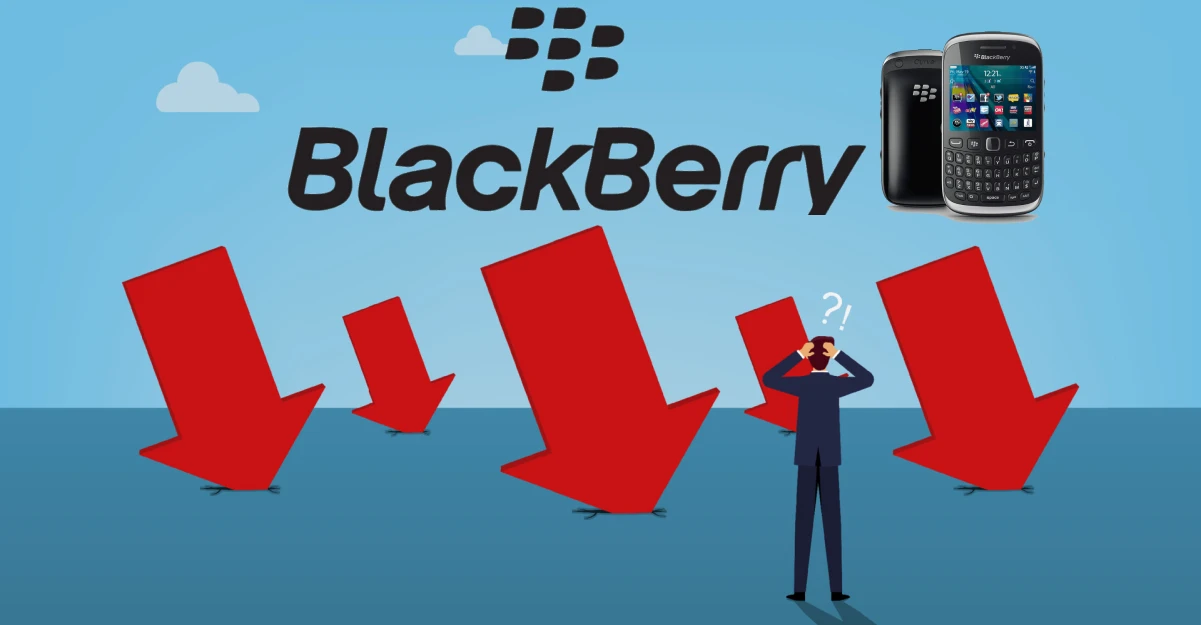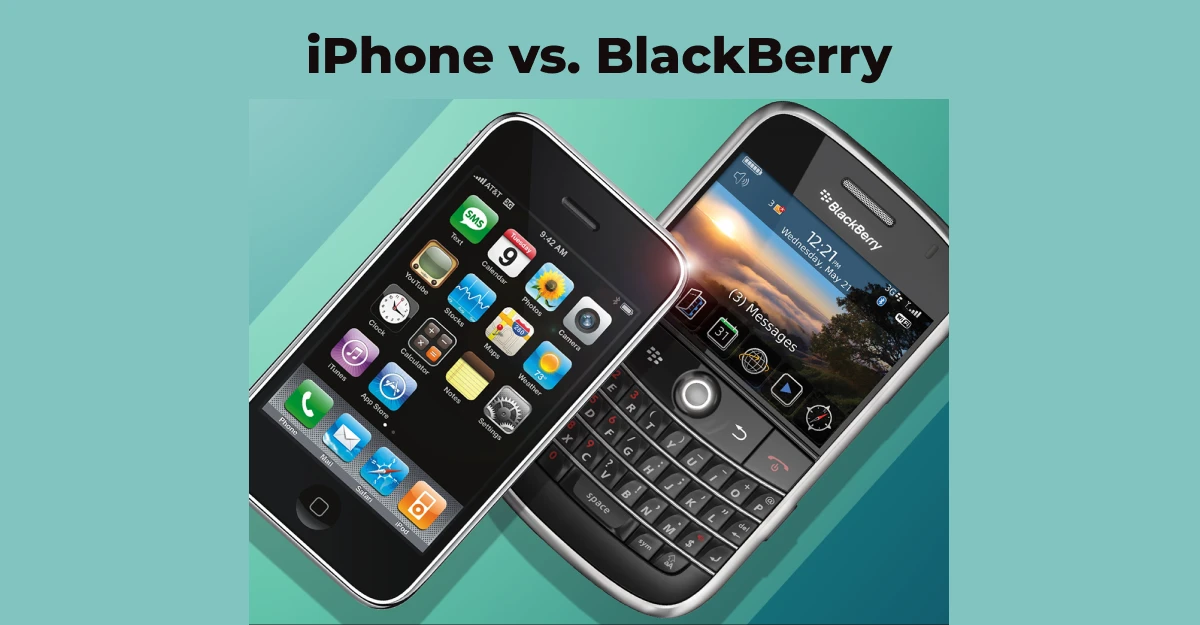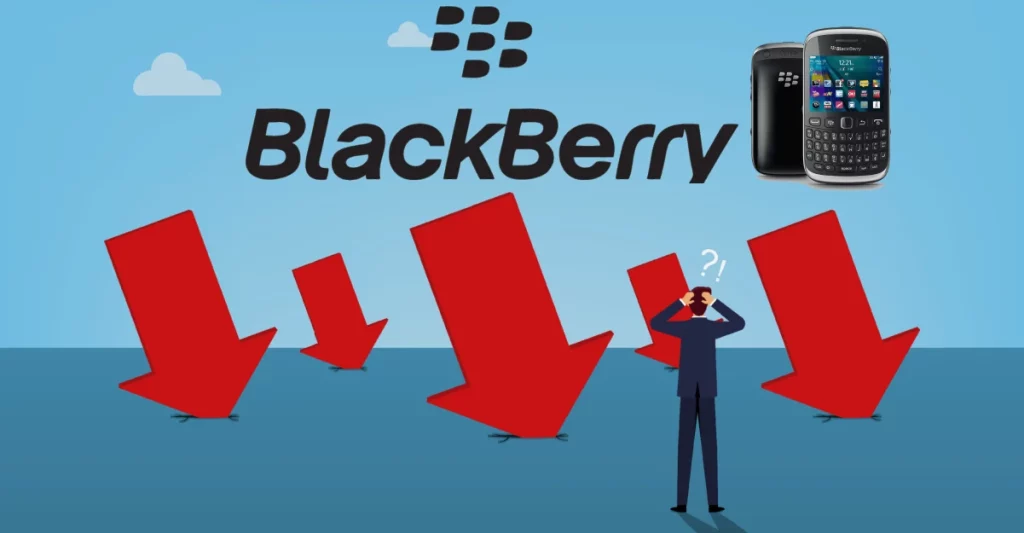As the saying goes- “What doesn’t change with time fades away…” Similar is the scenario with Blackberry!
Once a symbol of success and a titan in the mobile world- Blackberry (1999-2016), has become history. Meaning it doesn’t exist anymore as a mobile brand as it used to be a decade ago! It vanished in the third decade of the 21st century.

With over 85 million users in 2009-11, the smartphone brand was a dominant player in the global market. So, what happened all of a sudden that its market share dipped to less than 5% by 2012?
Who could have imagined that a brand that represented the professional status of people would meet a tragic fate? Doesn’t this fact make you curious to know- Why did Blackberry shut down? If yes, then stick to this article where we will discuss the rise and fall of the Black Titan.
Keep reading!
A Brief History of BlackBerry: Rise and Success
BlackBerry, originally known as Research In Motion (RIM), was founded in 1984 by Mike Lazaridis and Douglas Fregin in Canada. The company gained prominence in the late 1990s and early 2000s with the introduction of its iconic BlackBerry smartphones.
At that time Blackberry pioneered the introduction of highly anticipated features in a cell phone which were later given the title of “Smartphone.” Those devices offered features such as secure email communication, a physical QWERTY keyboard, and efficient data handling. Thus, Blackberry smartphones became popular among business professionals.

Apart from those qualities, BlackBerry’s success was attributed to its strong security and encryption technologies. The strong security and end-to-end encryption features were highly appealing to corporate and government users. It became the popular choice for enterprise users due to its secure messaging platform and reliability.
Key Developments of BlackBerry
Let’s cover the key milestones and developments of Blackberry-
| Timeline (Yearly Basis) | Key Developments |
| 1984 | Research In Motion (RIM) was founded in Waterloo (Canada) |
| 1999 | RIM released the BlackBerry 850 pager offering wireless email functionalities. This innovation marked the company’s entry into the mobile communication market. |
| 2002 | BlackBerry introduced its first smartphone, the BlackBerry 5810, which combined phone capabilities with email and text messaging. |
| 2004 | RIM launched the BlackBerry 7100 series, featuring a more consumer-friendly design and a SureType keyboard, appealing to a wider audience. |
| 2007 | BlackBerry gained significant popularity among business professionals and executives, earning the nickname “CrackBerry” due to its addictive appeal. |
| 2008 | The BlackBerry App World (later renamed BlackBerry World) was launched, providing a platform for users to download and install third-party applications. |
| 2009 | BlackBerry Messenger (BBM) was introduced, becoming a prominent instant messaging service for BlackBerry users worldwide. |
| 2010 | BlackBerry unveiled the BlackBerry Torch 9800, its first smartphone to feature both a physical keyboard and a touchscreen. This was an attempt to adapt to the market’s changing preferences. |
In the 1990s and 2000s, Blackberry was going through a purple patch. It was enjoying the benefits of monopoly. But the entire saga changed as soon as the new competitors entered the mobile communication market.
BlackBerry: Fall of the Black Titan
BlackBerry was a gigantic player in the segment of smartphones in the era of 2000s. In the year 2007, Apple launched its first iPhone with a touch screen and enhanced features. However, at that time BlackBerry was ruling the market and it took a long time for iPhone to establish a customer base. Apple Inc. targeted youths.

A few years later, folks were highly swayed by the touch screen and other playful features of the iPhone. And with no surprise, iPhone was a massive hit in the mobile market! It incorporated all the features that BlackBerry had and was successful to penetrate BlackBerry’s core customers. Such as business leaders and professionals.
And this was the beginning of BlackBerry’s downfall…
Timeline of BlackBerry’s downfall
Let’s look at the timeline of Black Titan’s demise-
| Timeline (Yearly Basis) | Events of BlackBerry’s downfall |
| 2011 | BlackBerry’s market share started to decline rapidly as Apple’s iPhone and Android smartphones dominated the market with their touch-based interfaces and extensive app ecosystems. |
| 2013 | BlackBerry 10, a completely redesigned operating system based on QNX, was launched with hopes of reviving the company’s fortunes. |
| 2014 | Facing financial difficulties and declining sales, BlackBerry announced a major restructuring plan, leading to significant layoffs. |
| 2016 | BlackBerry declared the end of designing its own BlackBerry smartphone devices. |
As BlackBerry lost its edge, its market share decreased significantly over time. Its stock price tanked from $147 in 2008 to $3.69 in 2023.
This was all about the journey of BlackBerry from sky-high achievements to miserable downfall. Now the most obvious question that may come to your mind is- Why did BlackBerry shutdown?
By shutdown, we mean the termination of manufacturing the smartphones. By now you must have realized that BlackBerry vanished due to the cloud-storming competition with iOS and Android. But that’s not all. There are many other reasons that led to this consequence.
Go through the next section where we will explore the reasons for BlackBerry shutdown one by one!
Why did BlackBerry shut down? Reasons for downfall
There are several factors that contributed to BlackBerry’s decline. Some of the key reasons are-
1. Rise of Touchscreen Smartphones
In the late 2000s, Apple’s iPhone and later Android-powered smartphones entered the market. As you have read above, Apple and Androids revolutionized the mobile industry with their touchscreen interfaces and app ecosystems. BlackBerry’s devices, which predominantly featured physical keyboards, struggled to keep up with the demand for touch-based devices.
The virtual keyboards proved to be more beneficial for folks as compared to physical keyboards. How? See, in touchscreen phones, when you are done with typing, the keyboard disappears to give you a larger space for media consumption. Therefore, day-to-day tasks like reading pdfs or watching videos become super easy.
That’s how the rise of touchscreen smartphones led to the decline/shutdown of BlackBerry phones.
2. Lack of Innovation
Well, this is the chief reason that led to BlackBerry’s failure (BlackBerry shutdown) in the mobile communications market. BlackBerry failed to keep pace with rapidly evolving consumer demands for new features and functionality. They were slow to adopt touchscreen technology and app stores, which further weakened their competitive position.

3. Ecosystem Challenges
Unlike Apple and Google, BlackBerry didn’t have a robust app ecosystem to support its devices. The limited availability of popular apps on BlackBerry devices made them less attractive to consumers. Eventually, it led to the shutdown of BlackBerry mobile devices.
4. Security Concerns
While BlackBerry was known for its strong security, even that advantage became less significant as competitors improved their security measures. This reduced the appeal of BlackBerry devices in the enterprise market.
5. Management Issues
BlackBerry faced internal management challenges, including leadership changes and corporate restructuring. This, in turn, impacted their ability to respond effectively to market changes. The management issues fueled BlackBerry shutdown.
6. Target Audience

BlackBerry had always targeted the rich segment of society. The commoners were never the priority audience of the Black Titan. And this proved to be a disastrous move for the company. How? Let me explain it in simple terms.
Can you guess why celebrities, businessmen, and other government officials used BlackBerry?
Due to security, email services, and advanced user interface.
Apple had beaten BlackBerry in terms of these features. And when BlackBerry was striving for keeping up with the competition. It decided to shift its focus to commoners to broaden the customer base.
But it was too late! Samsung had already entered the market with Android devices. And soon android devices witnessed massive growth worldwide.
While Android and iOS were proliferating, BlackBerry was fading in terms of every feature in the phones. Gradually, it lost its customer base too!
That’s why BlackBerry shutdown in the market.
Struggle for Revival
Despite facing all those challenges and heated competition, BlackBerry didn’t lose its spirit. Instead of manufacturing mobile phones, it shifted its focus to providing software solutions for industries.
Its revival strategy is described in the following table-
| Timeline (Yearly Basis) | Efforts for Revival in the market |
| Late 2016 | BlackBerry shifted its focus away from manufacturing smartphones and transitioned into a software and services company. It emphasized security solutions for enterprises. |
| 2017 | It made an ambitious move towards the Internet of Things (IoT) with the launch of the BlackBerry IoT Platform. It focussed on secure connectivity solutions. |
| 2018 | BlackBerry expanded its portfolio of secure software solutions and established partnerships with various companies to bolster its presence in the enterprise market. |
| 2019 | BlackBerry acquired Cylance, an artificial intelligence and cybersecurity company, to enhance its capabilities in the cybersecurity space. |
| 2020 | BlackBerry continued to provide secure software solutions, with a strong focus on industries such as the automotive, healthcare, and government sectors. |
| 2021-22 | BlackBerry maintained its presence as a specialized software company, offering secure communication and data management solutions for enterprise customers. |
| 2023 | As of the present year, BlackBerry continues to adapt to the ever-changing technology landscape. It provides innovative and secure software solutions to meet the needs of businesses and governments worldwide. |
BlackBerry’s journey has been marked by its initial dominance in the smartphone market, followed by challenges brought on by evolving consumer preferences and intense competition. Despite the ups and downs, BlackBerry has managed to carve a niche for itself in the realm of secure software solutions, leveraging its expertise in encryption and cybersecurity to serve its targeted clientele effectively.
Future Plans of BlackBerry

Will BlackBerry make a comeback? You may wonder. Although there have been reports of BlackBerry’s 5G smartphone. But no official statements about the same have been released by the company.
As of now, the company’s future plans were centered around its transformation into a specialized software and services company. Its key areas include-
1. Cybersecurity Solution
BlackBerry continues to offer cybersecurity solutions. How? By leveraging its expertise in encryption and secure communication to protect businesses and organizations from cyber threats. It provides provide secure communication and collaboration tools for enterprises and government agencies.
2. Internet of Things (IoT)
BlackBerry aims to expand its presence in the IoT space, providing secure connectivity solutions for connected devices and industries.
3. Automotive Software
BlackBerry is actively developing software for the automotive industry. Particularly for connected and autonomous vehicles, with an emphasis on safety and security.
4. Unified Endpoint Management (UEM)
The company offers UEM solutions to help businesses manage and secure various endpoints Such as mobile devices and computers, in a unified manner.
BlackBerry: A successful Cybersecurity and IoT service provider
Will the above solutions be effective for BlackBerry? You may ask. Yes, they are effective enough for BlackBerry’s survival. Currently, BlackBerry Limited is a solution provider of Cybersecurity and IoT services. Despite giving up on smartphones as a business, these services are significantly contributing to revenue.
Look at the revenue breakdown (FY23) of BlackBerry–
- IoT Revenue: $206 million
- Cybersecurity Revenue: $418 million
- Total Revenue: $656 million
Thus, you can say that the new operating segment of BlackBerry is more optimistic as compared to the smartphone segment.
What can you learn from BlackBerry’s failure?

From BlackBerry’s failure, you can learn the critical importance of adaptation, innovation, and customer-centricity in the ever-evolving tech industry. Failure to keep pace with changing consumer preferences and technological advancements led to its decline. A limited app ecosystem and an inability to transition swiftly to touch-based devices contributed to its downfall.
As you know the reason behind- Why did Blackberry shutdown? It is important to have a strong and diverse app ecosystem for attracting and retaining users. BlackBerry’s experience emphasizes the need for companies to be prepared for the worst situation in the future. They must continuously innovate, stay agile, and prioritize customer needs to maintain relevance and success in a competitive market. It serves as a cautionary tale, demonstrating that even industry leaders can lose their position if they fail to anticipate and respond effectively to market shifts.
Note: Recently, a movie named “BlackBerry” has been released. It tells the story of the company that once toppled global giants before facing tough competition in Silicon Valley. This movie offers a unique perspective and is not a conventional tale of modern business. You can watch to have a better understanding of “BlackBerry.”


I have used BlackBerry smartphone. Feeling sad to see its demise.
From BlackBerry’s failure, one can find easily the importance of adaptation, innovation, and customer-centricity in the ever-evolving tech industry. If the company fails to keep pace with changing consumer preferences and technological advancements, obviously it will face challenges and tough competition to stay in the market, and in the end, it has only one option which is to shut down. Because people are highly tech-driven and want new features along with a high kind of security. In the case of Blackberry, it failed to add new features, didn’t make many changes to the models, and much more. Apple came into the market and placed its position well by expanding its customer base. I would say with the passage of time, mobile sets must be updated with new advancements in technology.
Well explained!